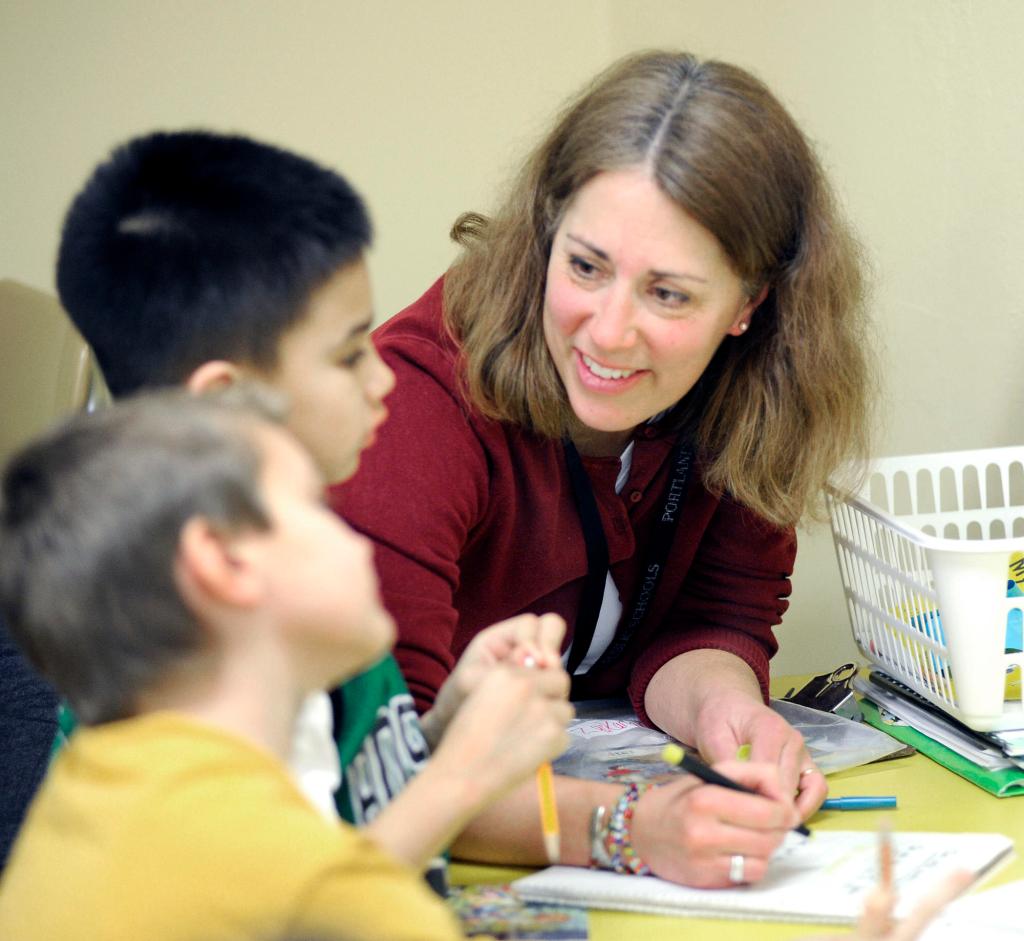PORTLAND – Lara Pratt recoils at the suggestion that she might hold some students back — actually provide remedial lessons they don’t need — to preserve her job as a special education teacher at Longfellow Elementary School.
Pratt, who struggled in school before finding her calling, tends a rotating flock of students who get extra help with reading, spelling, math and other subjects.
She sees 19 students each day in her resource classroom and monitors the educational services of three others in regular classrooms. All have varying degrees of learning disabilities and other challenges, such as speech problems and behavioral issues.
The kids come and go, spending a half-hour to two hours or more with her before returning to their regular classrooms. Each child gets group or one-on-one attention from either Pratt or her aide, Andrea Martelle.
The idea that any of Pratt’s students are needlessly identified for special education, as suggested in a recent report by American Educational Consultants, contradicts the purpose, energy and heart she brings to her job each day.
”It’s emotional,” Pratt admits, her eyes welling up as she tries to answer what feels like a personal attack. ”I’ve lost kids on my caseload because they’ve reached their goals. That’s celebration time for all of us, especially the parents. If I had to lose my job because all of my kids were back in the mainstream, I’d throw a party.”
In truth, Pratt worries about losing her job because Maine’s largest school district faces a $6 million reduction in state and federal funding in the coming year. The recent special education review concluded that Portland has too many resource room teachers and could save $2.5 million by cutting about 40 positions like hers.
”If we’re overstaffed, it’s not here,” said Pratt, 42, looking around her carpeted basement classroom. ”Thank goodness Andrea and I are a very good team. Once I’m teaching, it’s a well-oiled machine. For me, it’s all about the students and their success.”
State and federal regulations limit a resource room teacher’s caseload to 35 students, but many experts say a caseload of about 20 students is optimal. A recent district tally, though disputed by some principals, showed that several Portland schools average fewer than 15 students per resource room teacher, including East End, Lyseth, Reiche and Riverton elementary schools.
Dawn Carrigan, Longfellow’s principal, compares Pratt and other resource room teachers to orchestra conductors. A former special education teacher herself, Carrigan bristles at the premise that Pratt and her colleagues are padding learning disability diagnoses to keep their jobs.
”I have never met a special education teacher who was reluctant to send a child back into the mainstream,” Carrigan said. ”We have tremendous job security. Just walk down Congress Street. There are so many kids waiting for us because society keeps creating them for us every day.”
Carrigan said she’s especially worried that school officials will take the consultants’ report as gospel and cut necessary positions. She questions the validity of the report’s staffing recommendations because, for privacy reasons, the consultants weren’t allowed to view students’ individual educational plans, which dictate service levels.
Still, Carrigan’s also concerned that problems with the report, particularly around the accuracy of data provided by the school district, will diminish the valid recommendations it contains.
”There’s information in the report that’s dead on,” Carrigan said. ”I think there’s a strong desire among many of us to have a centralized, clear, consistent approach to special education that remains true to the needs of each child.”
That’s where Pratt’s role on the front lines is prominent.
As the school day proceeds, she never stops. Often, she’s juggling several tasks at one time. While leading a spelling lesson with one group of students, she directs a writing lesson for other students, minds an occupational therapy session in the hallway and keeps an eye on one student who needs more of her attention than others.
Zack LaCour, a second-grader with a cherub’s face and short swirl of blond hair, is one of Pratt’s success stories. Zack returned to Longfellow this year after going through a series of difficult transitions that made it nearly impossible for him to learn in a regular classroom.
Now, Zack spends four hours each day in Pratt’s classroom, where she constantly reassures him, directs him and recognizes every achievement. At one point, Pratt sees Zack collaborating with another student, something that wouldn’t have happened a few months ago. Pratt’s joy is palpable.
”Many of my students have been under the table screaming, slamming the door, acting out in various ways, but you didn’t see that today,” Pratt said. ”Each year it’s about moving them all closer to their goals, sometimes in baby steps.”
Staff Writer Kelley Bouchard can be contacted at 791-6328 or at: kbouchard@pressherald.com
Copy the Story Link
Send questions/comments to the editors.



Success. Please wait for the page to reload. If the page does not reload within 5 seconds, please refresh the page.
Enter your email and password to access comments.
Hi, to comment on stories you must . This profile is in addition to your subscription and website login.
Already have a commenting profile? .
Invalid username/password.
Please check your email to confirm and complete your registration.
Only subscribers are eligible to post comments. Please subscribe or login first for digital access. Here’s why.
Use the form below to reset your password. When you've submitted your account email, we will send an email with a reset code.